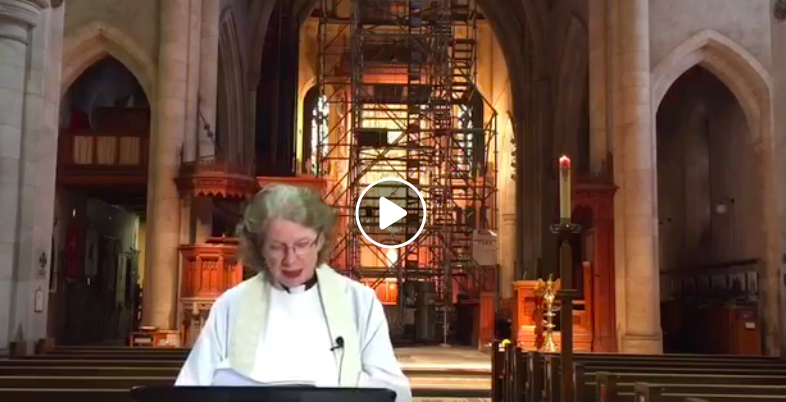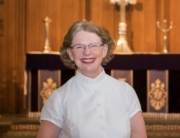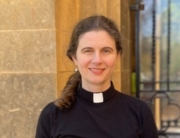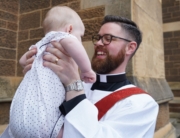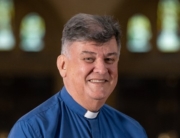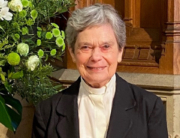A sermon by The Rev’d Canon Jenny Wilson
In the name of God, creating, redeeming, sanctifying, … Amen
Over the past weeks of the Easter season, a season we have spent with the family that is now our whole world in strange isolation, we have heard three stories of resurrection. Each of these stories has within them an image of grief, containment, confusion, and an image of Jesus’ utterly alive presence. On Easter Day, we reflected in a garden nearby the tomb where Jesus’ body had lain, and we heard the one who appeared as a gardener speaking Mary Magdalene’s name. The following Sunday, we found ourselves with the frightened disciples in a locked upper room. Jesus entered the room speaking words of peace and calm and a week later to Thomas who doubted, he showed his hands still pierced by the nails and his side still wounded by the spear. “Do not doubt but believe,” he said to Thomas, “Blessed are those who have not seen and yet have come to believe,” he said, perhaps to us. Last Sunday, we found ourselves on the Road to Emmaus with the disciples, grief stricken and bewildered, disciples who found themselves in the company of one who spoke with them about the stories of scripture in which their lives were held and in which they found meaning. This stranger broke bread with them and then they knew. This one who had caused their hearts to burn along the road was Jesus. Each Sunday the disciples imprisoned in fear and grief found themselves encountered by their risen Lord. Each Sunday death was encountered by life.
This Sunday, the Fourth Sunday of Easter, we find ourselves taken back into the Gospel of John, to Chapter 10, in fact, where we hear Jesus speak of himself as Shepherd. It is as if those who prepare our lectionary, the book that guides us in our readings of scripture, think that we have, surely, got it by now. We have surely taken it in, in some small way, that Jesus is risen. Indeed, that the one we saw die in agony on Good Friday, is now alive. And that now we might reflect a little on the nature of this alive one, the nature of Jesus whose spirit is with us, and the nature of our relationship with him.
Very truly, I tell you, Jesus says, anyone who does not enter the sheepfold by the gate but climbs in by another way is a thief and a bandit. The one who enters by the gate is the shepherd of the sheep. The gatekeeper opens the gate for him, and the sheep hear his voice. He calls his own sheep by name and leads them out. When he has brought out all his own, he goes ahead of them, and the sheep follow him because they know his voice.’ (John 10:1-4)
The context of this passage is a surprise. It is the scene where Jesus has just healed the man born blind. Do you remember? We spent time with this story, from John Chapter 9, on our first Sunday in isolation. Jesus healed the man born blind and everyone was confused. The religious leaders challenged the man, and his parents, and the man just said to them “The man called Jesus made mud, spread it on my eyes and told me to wash.” Do you remember? The Pharisees drove him out and the man called Jesus noticed that. Noticed a child of God driven out of the place of God. And then Jesus went on to speak the words we read this morning. Clearly inviting the religious leaders to reflect on what sort of guides for the people of God they were.
Jesus uses the image of a sheepfold. The contrast he makes is harsh. Thieves and bandits … or shepherds. Thieves steal by deceit, bandits by violence. All who encounter them are made less than they were before, are deprived of life. The shepherd calls the sheep by name and leads. They know his voice. And the shepherd gives life, brings the sheep to safe pasture, a place to feed, a place to thrive, a place of protection. And the sheep? They are “his own.” This phrase matters. Jesus says it twice. “He calls his own sheep” … “When he has brought out all his own”… This phrase echoes the Prologue of the Gospel according to St. John, the poetry at the beginning of the Gospel upon which the whole gospel is grounded. “Jesus came to what was his own, and his own people did not accept him,” it says in verse 11.
Those listening to Jesus at the time of this conversation, and we who are listening now, are invited to reflect on who it is we allow to lead us and, in particular, on the nature of God. God is shepherd. We are God’s own.
The image of God as shepherd is a key image for the people of Israel, an image found in many of the psalms. The psalm set for this “Good Shepherd Sunday” will come as no surprise. Psalm 23 which opens “The Lord is my shepherd, I shall not want” is well known and dearly loved. We can struggle, though, to be moved by it, it can struggle to reach us, if you like, as any story or poetry or hymn that we know almost too well can struggle to affect us.
What might we do with this image of shepherd in our time of isolation due to the pandemic? What might we do with this image of us, whose names are known, who are God’s own, who hear God’s voice? And what of the fierce image of thieves and bandits? Is the virus a thief, a bandit? Or the fear that accompanies it? Things that steal from us our normal life, for some their very life, or their loved ones’ lives.
This morning’s gospel reading introduces another image for Jesus. The image of a gate.
Jesus said to them, ‘Very truly, I tell you, I am the gate for the sheep. All who came before me are thieves and bandits; but the sheep did not listen to them. I am the gate. Whoever enters by me will be saved, and will come in and go out and find pasture. (John 10:7-9)
The gate is the way in to the sheepfold, the place of life. And I wonder if we might ponder the way this gate works. We might remember that in the Prologue to John’s Gospel, Jesus is called the Word, what scholars sometimes call God’s self-communication, the way God helps us know God, know God’s presence with us, know what God is like. We might wonder if the gate to the sheepfold somehow gathers us in by helping us imagine what God is like and what we are like in relationship with God at this time. And that we might reflect, guided by the spirit of this man called Jesus, on the images we have been given in the past weeks. Which one most resonates with our time in isolation, separated from our church community and most of our family and friends? Does it feel like a tomb, or a locked room, or a path on which we are walking baffled and sad? Or do we resonate with the image of a sheepfold that encloses us, certainly, but where we know welcome and safety and good food, is that an image that we are growing to find familiarity with as the weeks go by.
The Old Teastament scholar Walter Brueggemann often reflects on the power of words and images and, speaking about the psalms, he said the following:
“language leads experience, so that the speaker speaks what is unknown and unexperienced until it is finally bought to speech. It is not this way until it is said to be this way.”[1]
Language leads
experience. And story leads experience too. Stories from scripture,
particularly. It is the living word of God, after all. Might we reflect on the
story that has most drawn us, resonated with us, even called out to us in the
past weeks. Might we sit with that story, allowing it to lead us, knowing that
the man called Jesus is with us, is shepherd and guide and gate even into life at
this pandemic time. Might the image from the scriptures that most calls out to
us in this Easter season lead us more fully into the experience that is life as
one of God’s own.
[1] Walter Brueggemann The Spirituality of the Psalms, pp28-9.

